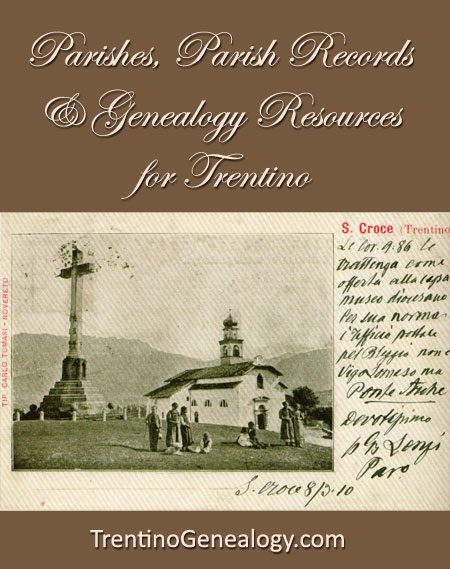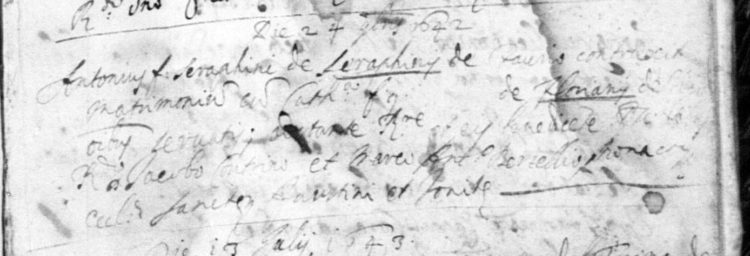
Genealogist Lynn Serafinn tells what you can learn from church records, the role of the parish in Trentini life, and where to look for your ancestors’ records.
Perhaps the biggest question people have when they want to create their family tree is, ‘How do I START?’ The task of researching your Trentino family history can seem daunting, especially if your Trentini ancestor is more than a generation away from you, i.e. a grandparent or great-grandparent.
In my opinion, the best starting point is to look at parish records. I’ll be talking a lot about the ‘how to’ of parish records in later articles, but today I want to lay the groundwork by explaining what they are, how parishes operated in our ancestors’ lives, and what available resources there are for the parish records of the Catholic Archdiocese of Trento (which covers all of the province of Trentino).
What Are Parish Records and When Did They Start?
Parish records (registri parrocchiali, in Italian) are books kept by the parish priests to record important events that took place in their parish, including (but not limited to) the ‘vital’ records of baptisms, marriages and deaths of all their parishioners. Some church records include confirmations, first communions and church census records, but these are generally only accessible if you go directly to the parish itself and view the original records.
The keeping of parish records was first mandated by the Catholic Church in 1563, at the Council of Trent (Trento), when all Catholic churches were directed to keep records of all baptisms, marriages and deaths within their parish. Some parishes, including Santa Croce del Bleggio where the majority of my Trentini ancestors lived at that time, was one of the early conformists to this new regulation, and you will see baptisms and marriages appearing as early as 1565. Many parishes were late to adopt the practice, although most kept records of births and marriages by 1595. In many parishes, the regular practice of keeping death records appeared slightly later.
Bearing in mind that civil records in Italy began around the time of the Napoleonic wars in the early 1800s (and, even more significantly, Trentino has only been part of Italy since the end of the First World War), Catholic parish records are vital to genealogical research in Trentino.
The Role of Parishes in Our Ancestors’ Lives
The more I research my ancestors, the more I come to respect the role of the parish in their everyday lives. A parish was (and still is) more than the place to go to church. This church was a portal of all rites of passage – coming into the world, unifying for the purpose of procreation and, ultimately, leaving the world. It was the place where people came together on a regular basis, and where everyone knew everyone else. It was also where families in need could find support. In fact, a progressive, rural cooperative movement – aimed at helping poor, farming families – was established in 1890 by the priest don Lorenzo Guetti (of Vigo Lomaso), assisted by don Giovanni Battista Lenzi (of Santa Croce).
Church records are not merely repositories of your ancestors’ vital information. Within them, you can also find evidence of friendships and long-standing alliances between families, as well as clues as to the occupations and reputations of various individuals within the community. Digging really deeply into them, you can see the heartache of loss, and both the fragility and the tenacity of human existence. Some parish records can even provide us with a microcosm of contemporary community life, and the concerns of its people. I read some heart-rending accounts penned by don Lenzi during the first decades of the 20th Century, where he shared his feelings on the tragedy of the First World War and his reflections on the trend of mass immigration to the Americas. I even read an account about a devastating fire that took place in 1916 in the house of my great-grandfather.
Parishes and Life Events – Where Did They Take Place?
Marriages normally took place in the parish church of the bride, or sometimes a smaller church in the bride’s frazione (village). As the vast majority of marriages took place between two people from the same parish (and sometimes even from the same frazione), you can often trace many generations of your Trentini ancestors within a single parish. If you cannot locate a marriage record for a couple, it is often an indication that the wife came from a different parish. In such a case, you might have luck looking at marriages that took place in parishes nearby that of the husband.
After a couple married, they normally went to live in the husband’s frazione of origin. This means any baptismal records of children born from that marriage would be born in their father’s parish. The fact that wives tended to move to their husband’s frazione means that over the generations, each frazione came to be associated with specific families. For example, if you say the surnames ‘Crosina’ or ‘Farina’ in the parish of Santa Croce del Bleggio where my ancestors came from, 99% of the time they will have been born in the frazione of Balbido. Knowing these kinds of trends can really expedite your research, especially because some priests organised baptismal records according to the frazione.
Burials, of course, would be registered in the parish in which the person was living at the time of death. Thus, a woman born in one parish will most likely have been buried in her husband’s parish.
Exceptions to the Rule
There are always exceptions to these patterns. Sometimes a bride is the last surviving child from her parents’ marriage, or is the eldest daughter, with no brothers. In such cases (and especially if the groom came from a family where there were many sons), the groom would likely move into the home of the bride and the couple would take ownership of the father’s property upon his demise. Occasionally, if an unmarried man married a widowed woman, he might move into the home in which she had lived with her late husband. Because such exceptions sometimes arise, if you are having difficulty finding the baptismal records for the children of this couple in the village of the father, the most likely place to look would be the village of origin of the wife.
Another exception is when the husband is a person of import – a notary or judge, for example. Such men might be assigned to an official post in another parish. In such cases, the whole family would move to this new parish, which might have no ancestral connection to either the husband or the wife. For example, my grandmother’s line, the Onorati, had several notaries in the family, going back many centuries. Although their ancestral village is in the frazione of Bono (Santa Croce del Bleggio parish), a few Onorati families lived in other parishes for short periods of time, when the heads of the families were posted at castles like Stenico (Tavodo parish) and Castel Campo (Vigo Lomaso parish). Thus, if you want to find the records for children born during those years, they may be in the parish of origin OR in the ‘adopted’ parish. Sometimes, you will find the records in both parishes. On the other hand, if you’re unlucky, they might be missing in both.
SIDE NOTE: All of these habits were the norm in Trentino prior to WW1. While these trends still exist today, the way many people live, marry and work has changed significantly over the past century, as people have become more mobile.
Changes in Parish ‘Boundaries’ Over Time
Parishes are not ‘fixed in stone’ entities. As populations rise and fall, some parishes will merge together, while others will split apart. Some very tiny frazioni have shifted around a lot over the centuries, appearing in one set of parish records for a period of time, and then in another later on. One example is the frazione of Saone, which was originally part of the Bleggio parish, but later became a parish of its own. Another is the frazione of Favrio in the current-day parish of Ragoli, the records of which over the centuries were constantly shifting back and forth between the parish of Ragoli and Thione. As a result, there are significant gaps in the early church records for these villages. Sometimes entire decades are missing.
If you cannot find the records you are looking for, don’t give up until you have exhausted all the most likely possibilities. Look on a map and see which parishes border your ancestors’ usual parish of origin, and check those records before resigning yourself to the fact they may no longer exist (if they ever did). For three years I believed I would never find the marriage record for my 7x Serafini great-grandparents. But a few months ago, I ‘stumbled’ upon the very record (from 1642) when I was searching for something else in a nearby parish.
Click on the image below to see it larger.

Where Can I Find and Search Trentini Parish Records?
We Trentini are particularly fortunate because we have three excellent resources to access the parish records of our ancestors:
- Nati Trentino – a free, searchable website containing basic information from the all baptismal records for the Archdiocese of Trento between 1815 – 1923
- Microfilms made by the Latter Day Saints (LDS) – rentable films of all available baptisms, marriages and death records from the Archdiocese of Trento between 1550s – 1923
- Archives of Archdiocese of Trento, in Trento, Italy – research facility of digital images of all available baptisms, marriages and death records from the Archdiocese of Trento between 1550s – 1923
While I work regularly with all three of these resources, my favourite is the Archives in Trento. Of course, utilising the Archives of the Archdiocese requires physically going to Trento (as these resources are not available online). This is impractical for many, especially those who live in North America and/or don’t speak Italian. Even if you do make the trip, knowing how to find and understand what you’re looking for is not something easily done if you’re just starting out in your genealogical quest.
That’s why, when someone is just starting out, I normally recommend they use the Nati Trentino website. They have a REALLY long link to get to the English research portal:
Coming Up Next Time…
In the next article on Trentino Genealogy, I’ll be giving you a quick tour of Nati Trentino. In that article, I’ll be looking at:
- What the site can tell you (and what it cannot)
- Technical limitations of the site and tips for working around them
- What to do if you don’t know your ancestors’ parish
- Tips on what to do if you’re not certain of your ancestors’ original name
- Troubleshooting and strategies to use when you seem to be stuck
After that, I’ll be sharing my tips on finding and using LDS microfilms, working with the Trento Archives, and ways you can take your research beyond parish records.
I hope you’ll subscribe to this blog so you can read all future articles on this site. Desktop viewers can subscribe using the form at the right side at the top of your screen. If you are viewing on a mobile device and cannot see the form, you can subscribe by sending a blank email to trentinogenealogy@getresponse.net.
Also, if you’d like to talk to me about researching your family history, you are most welcome to drop me a line via the contact form on this site.
Warm wishes,
Lynn Serafinn
Subscribe to receive all upcoming articles from Trentino Genealogy! Desktop viewers can subscribe using the form at the right side at the top of your screen. If you are viewing on a mobile device and cannot see the form, you can subscribe by sending a blank email to trentinogenealogy@getresponse.net.
Lynn on Twitter: http://twitter.com/LynnSerafinn
Join our Trentino Genealogy Group on Facebook: http://facebook.com/groups/TrentinoGenealogy
View My Santa Croce del Bleggio Family Tree on Ancestry:
https://www.ancestry.com/family-tree/tree/161928829

LYNN SERAFINN is a bestselling author and genealogist specialising in the families of Trentino. She is also the author of the regularly featured column ‘Genealogy Corner’ for Filò Magazine: A Journal for Tyrolean Americans.
In addition to her work for clients, her personal research project is to transcribe all the parish records for the parish of Santa Croce del Bleggio (where her father was born) from the 1400s to the current era, as well as to connect as many living people as she can who were either born in Bleggio or whose ancestors came from there. She hopes this tree, which already contains tens of thousands of people, will serve as a visual and spiritual reminder of how we are all fundamentally connected.
View the Santa Croce del Bleggio Family Tree on Ancestry:
https://www.ancestry.com/family-tree/tree/161928829
CLICK HERE to view a searchable database of Trentini SURNAMES.

One thought on “Parishes, Parish Records & Genealogy Resources for Trentino”